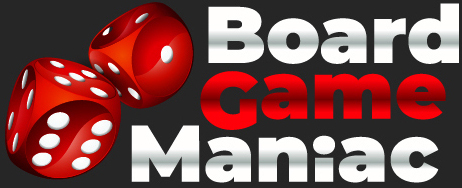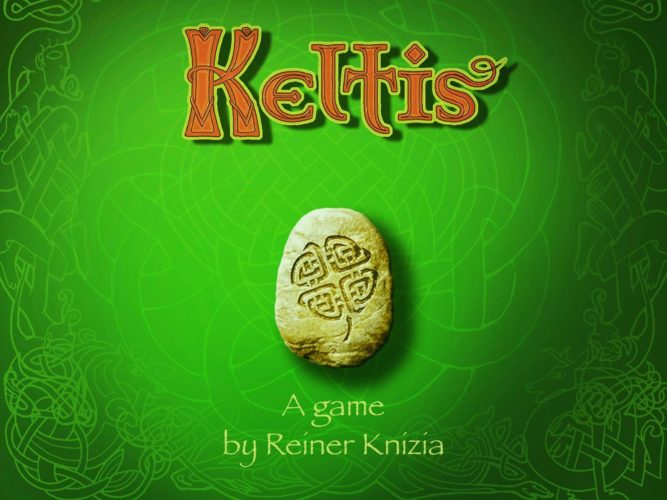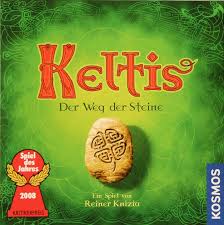When it comes to board games being designed for the digital media, expectations regarding the design, the interface and gameplay rise a lot as people who have played the board game expect to have a similar or even better playing experience than that of tabletop gaming. That introduces a great challenge for the software companies in order to match the tabletop feeling while still staying attractive to players that never played the board game. Keltis HD is another board game app implemented for the iPad by Quadriga Games and published by USM Games. Does it meet the challenge of being competitive against the thousand other games for iPad and the dozens other board game apps? Read on to find out.
Keltis is an abstract game, designed by the renowned Reiner Knizia and first published in 2008 as a board game. The same year, it won the prestigious “Spiel des Jahres” (“Game of the Year”) award in Germany. It is played by 2-4 players and lasts about 20 minutes. Players have to follow paths of stone and advance their figures as far as they can along these paths. There are 5 such paths, each one using a different color / symbol and depicted by a straight line of light and dark stones. All paths start from a big common stone where players’ figures are initially placed. In order to advance along the stone paths, players use cards carrying the corresponding symbol and a number (0-10). These cards are layed down in ascending or descending order in each player’s placement area. The order of the cards is decided when a player plays the second card of the same symbol and can’t be changed during the course of the game. In order to make each game unique, different path tiles are put on dark stones each time. The path tiles available are:
- Wishing stones. Players must collect as many as they can. When none or one is collected, the player receives negative points.
- Point tiles (1 to 3). When a player steps on a stone with a point tile, he immediately receives the points written on the tile.
- Clover leaves. When a player steps on a stone with a clover leaf, he can choose a figure to advance one step forward for free.
At the beginning of the game, path tiles are shuffled and put randomly on dark stones. Each player receives 5 figures (4 small ones and 1 big). The cards of the game are shuffled and 8 are dealt to each player. The rest form a draw pile.
Each player on his turn must either play a card or discard one. There are 5 columns (1 for each symbol) that serve as placement area for cards. Cards can be played in an ascending or descending order. A card with the same value as the previous one can also be played immediately after it. When playing a card, the player’s figure on the corresponding path is moved one step forward. Alternatively the player can discard a card from his hand. There is a separate discard pile for each of the 5 colors/symbols. After playing or discarding a card, the player must draw a card from the draw pile or one of the discard piles.
The final score of the game is determined by how much a player’s figures have advanced along the paths and how many wishing stones and points he has collected. The large figure scores double points (positive or negative ones).
There are 3 scoring zones for each of the stone paths, each one spanning 3 rows. When a figure ends up in a row in the first zone at the end of the game, the player receives negative points. In the next zone, players receive 1 to 3 points and in the third 6 to 10 points. The game ends when 5 figures, belonging to any player, have entered the third scoring zone.
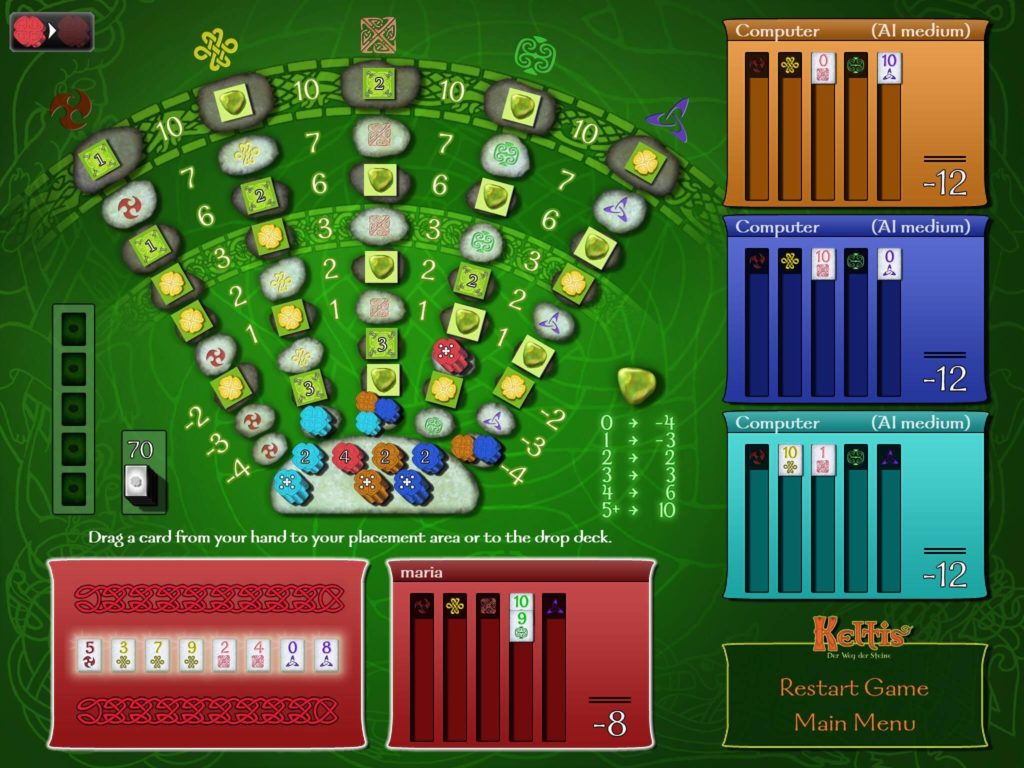
Digital implementation
Implementing a game like Keltis for iPad had many challenges to meet. The graphics of the game should match those of the board game, giving attention to detail while making the different symbols and colors recognizable. The layout of the board and all players’ placement areas had to be studied with caution in order to make the most of the iPad’s screen. Working on the AI of the game must also have been a great challenge. Let’s see how Keltis HD has done in our usual scoring categories:
Graphics
Keltis is beautifully designed, using the original artwork of the board game. Green is the dominant color bringing a sense of tranquility and calmness to players in combination with the music. The board takes up the best portion of the screen and players’ placement areas fill the rest. The screen seems a bit crowded and the numbers on cards appear a bit small as are the game board elements. This can be a little tiring but I’m not sure anything better could be achieved. Although the iPad’s screen is pretty big, sometimes you can’t get enough of more space. This is a game that I would surely like to try in an iPad Pro. 7/10
Gameplay
Reiner Knizia is a master at balancing the gameplay in abstract games such as Keltis and minimizing the element of luck. Players have to make important decisions all the way through the game. At the beginning they have to consider in which path to use the large figure (remember that it scores double points) and choose the right time to start a new path, usually when they feel confident enough by having enough cards to continue in this path. Choosing the right order of the cards must also be done with caution. Turns in which you discard cards instead of playing them, seem kind of useless towards achieving your goal, so they must be minimized but when the cards in your hand are far off from the sequences of numbers already played, the choice will get tough. I liked the fact that in this digital implementation, you see your score constantly during the game and that gives you a precise view of how you are doing in the game. In the tabletop game you would have to make calculations constantly if you would like to know your score, let alone that you should do that for your opponents as well.
For those of you that enjoy solitaire gaming there is also a single player campaign mode in Keltis, including 4 paths. The first one, “Sandstone path” is available for free and the other 3 can be unlocked through an App purchase. The campaign has an increasing difficulty that keeps you engaged and adds replayability to the game. In the campaign there is no opponent, instead your figures must be moved as far as possible along the paths of stone to achieve a target score. Each path has 4 rounds of play, each one with slightly different rules (number of paths available and cards in your hand) which makes the campaign very interesting. At the end of each path, you are awarded with bonus objects, such as large figures and clover-leaf tokens that you can use in the next path. You can play each path as many times as you like to improve your high score and earn more bonus objects. In the campaign, additional path tiles are used, namely, coins that contribute to bonus points at the end of a path, skulls that force the players’ figure to go back along a path and cards that replenish the draw-pile.
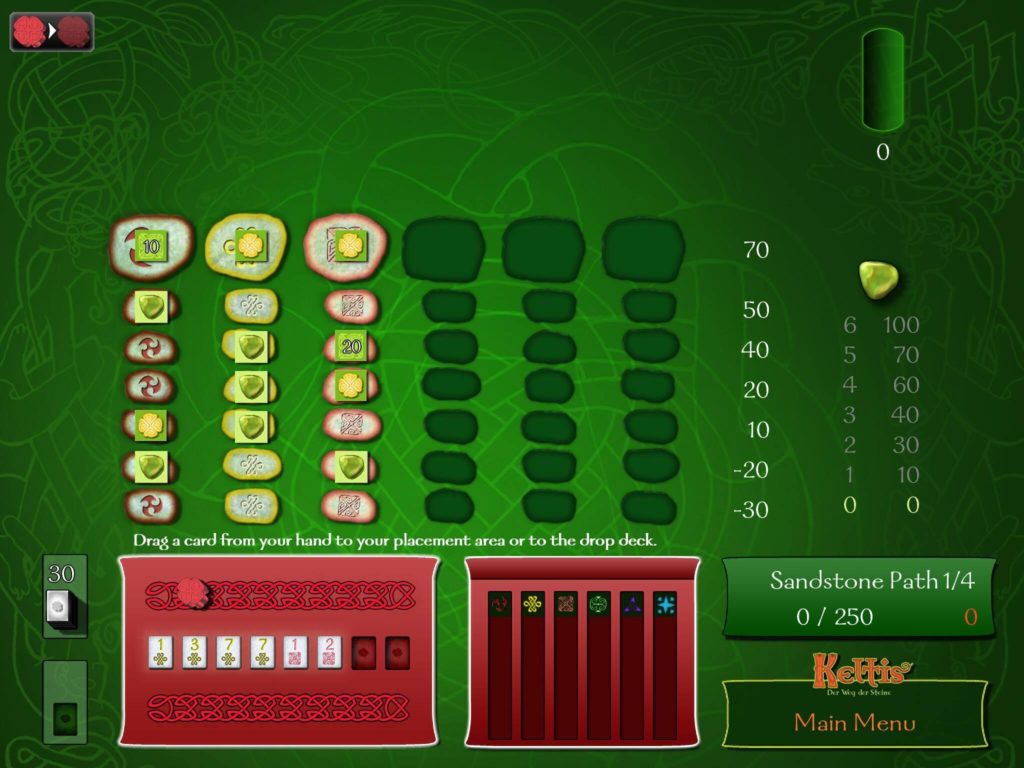
Apart from the basic game, a little expansion named “New challenges” is available from the App Store. It uses a new board layout and AI controlled opponents for added hours of fun.
All in all a very good implementation leaving nothing more to be desired, regarding gameplay. 7/10
UI (User Interface)
The UI of Keltis HD is very friendly. Players can easily drag the cards in the placement area or the drop deck or just tap the card and then tap its destination. The movement of the corresponding figure is then done automatically except if it is the first card played for that path in which case you have to choose a figure to assign to that path. An interesting in-game function enables players to temporarily make players’ figures transparent, so that you can clearly see all the path tiles that are hidden under them.
The most interesting thing about the game’s UI is the local multiplayer mode where there are 2 different layouts to choose from. You can choose either the standard layout or the table mode. In standard layout all players’ placement areas face the front side of the iPad. In table mode, it is assumed that players seat around a table and the placement areas for each player are oriented in a way that each player can see his placement area in front of him. This mode is very handy when playing with more than 3 people because it would be very difficult for them to all sit in front of the device and quiet tiresome to hand over the device to each player on his turn. 8/10
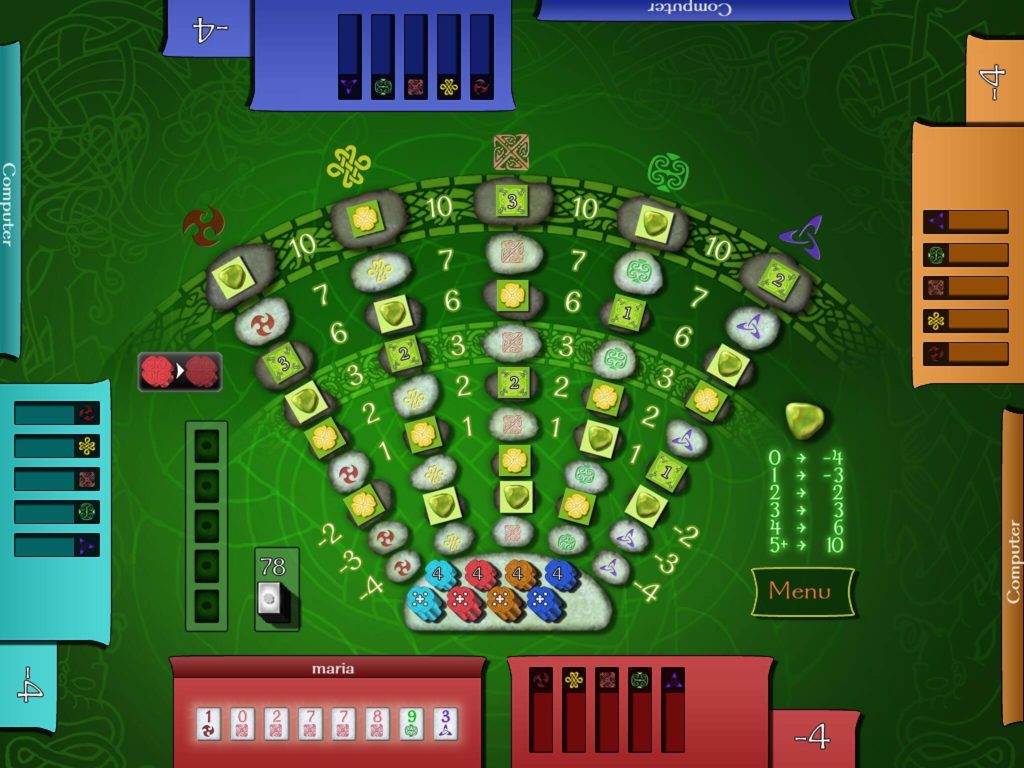
Learning Curve
The idea behind the game is pretty simple, although mastering the game can be tougher than you think. The simple, written tutorial guides you through all aspects of the game. I would personally prefer an animated tutorial or a real time tutorial with tips appearing in crucial points during the game, as that is the trend in digital games and is far more appealing to players. However Keltis is an easy game to learn and the tutorial covers everything adequately. You will have no trouble learning how to play within minutes. 8/10
AI
In case you have no one to play with, you can always start a new game with one to three computer opponents. Their level can be Easy, Medium or Hard. The medium and hard levels present very competitive opponents that you will have to try hard to win. The programmers have done a nice job, fine tuning the computer opponents’ behavior and making them take the best possible decisions. 10/10
Multiplayer
Keltis HD gives you the opportunity to create 4 different users in the game. You can select a user each time you open the app. That is very handy if more than one people use the tablet. Each one can have his own achievements and a personalized experience of the game. You can also use these users to create hot-seat multiplayer games. In local multiplayer games you have the opportunity to play with real people or the AI or a mix of the two.
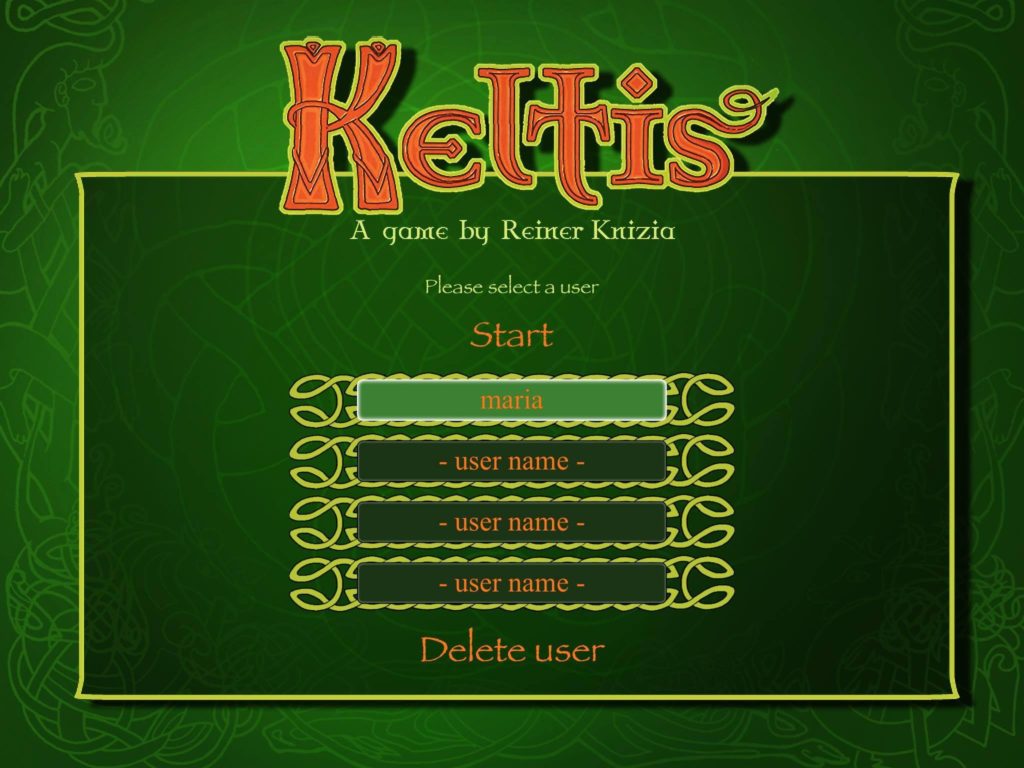
An online multiplayer mode is also available for those who would like to test their skills against other remote players. This is achieved through Game Center but I was never able to find other players this way, no matter how many times I tried. The best way to use this feature is to invite some friends (already in your friend list in Game Center). 7/10
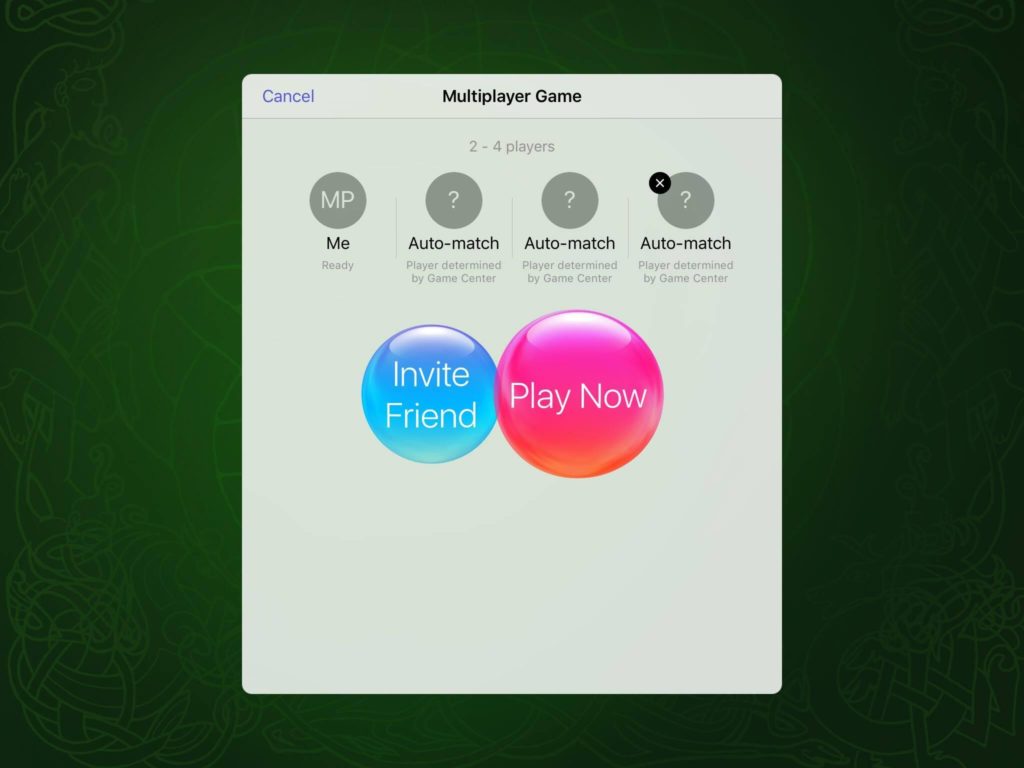
Replayablity
Thanks to the flawless implementation of the game, its short duration and the rich features regarding modes of play, Keltis HD is a game that makes me want to play more and more. This feeling is enhanced by the skillful design of the AI and the presence of the campaign. 8/10
Final Verdict
Keltis HD is a fine app for the iPad, combining simplicity and strategic thinking in a quick game, which successfully simulates the renowned tabletop board game. It’s easy to learn and the user interface is very simple and friendly. The many modes of play, including the option to play with your friends while sitting around a table, enhance replayability. However, the online multiplayer mode, using Game Center, rarely finds any opponents. The AI is skillfully programmed, making computer opponents very worthy. Keltis is a bug-free app with great value for money.
Recommended for: Abstract game fans, Strategy game fans
According to our scoring system, scoring categories have different weights. Graphics have 10% weight, Gameplay 25%, Learning curve 5%, User Interface 15%, AI 15%, Multiplayer 15%, Replayability 15%. According to this system and the above scoring in each category, overall weighted scoring of the game is:
Overall: 7
I would like to thank USM Games for providing a promo copy of the game.
